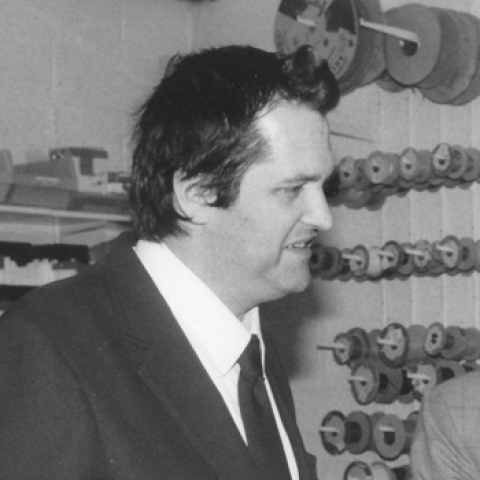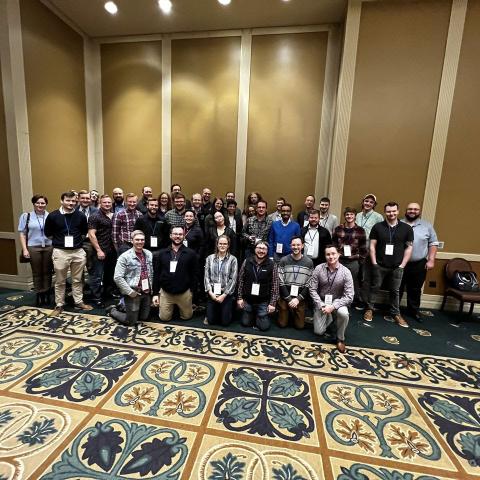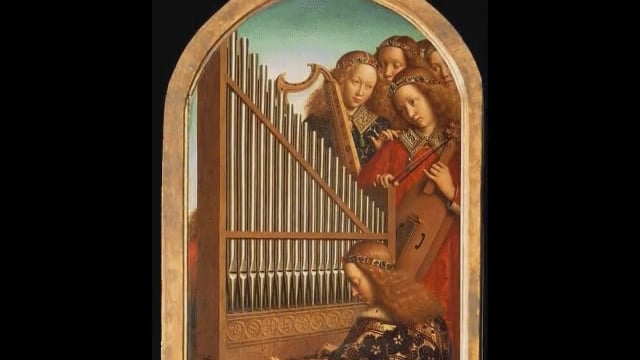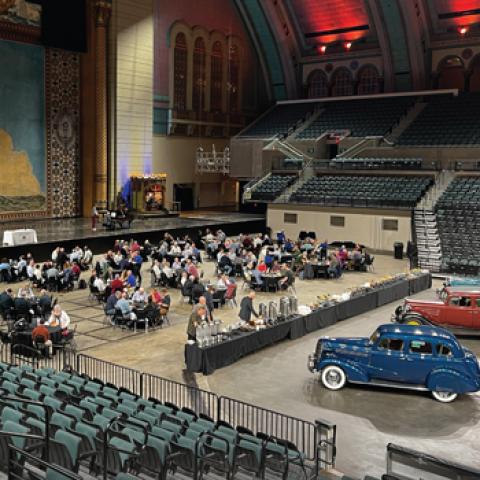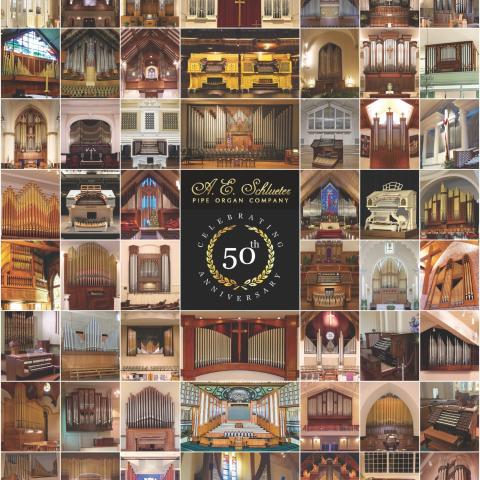The American Institute of Organbuilders Celebrates Fifty Years
Matthew M. Bellocchio is a charter member of the American Institute of Organbuilders and earned the Fellow Certificate in 1979. He chaired the AIO education committee (1997–2009), served two terms on the AIO board of directors (1993–1996; 2010–2012), and as AIO president (2012–2015). He is a senior manager and designer at Andover Organ Company in Lawrence, Massachusetts, which he joined in 2003. He is also president of the Methuen Memorial Music Hall, Inc., where he has served as a trustee since 2017.
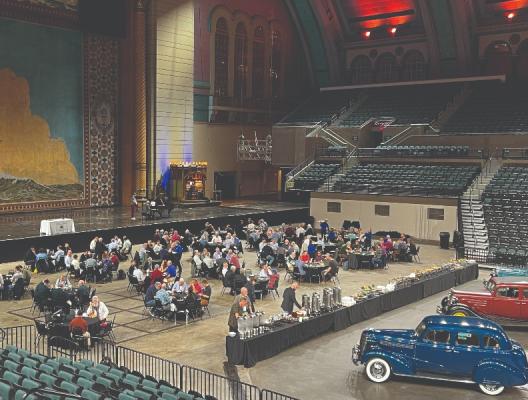
September 2024 marks the fiftieth anniversary of the chartering of the American Institute of Organbuilders (AIO), a unique organization that has had a transformative effect on American organbuilding. Anniversaries invite us to reflect upon our past and contemplate how far we have come. Thus, this article will describe the history of the AIO, its programs, and its impact.
Beginnings
In 1970 David W. Cogswell and Jan R. Rowland of the Berkshire Organ Company in West Springfield, Massachusetts, attended their first biennial Congress of the International Society of Organbuilders (ISO) in Switzerland. Inspired by the collegial atmosphere and sharing of knowledge that he experienced, Cogswell conceived the idea of forming a similar organization for United States and Canadian organbuilders. He calculated that it would be economically viable to organize a meeting of organbuilding individuals if at least ninety persons paid and attended. Advertisements were placed in organ journals, and a printed program booklet was mailed to all known organbuilding and maintenance companies for the “First North American Organbuilders’ Convention,” which took place in Washington, D.C., September 2–5, 1973. Auspiciously, 110 people attended.
The participants were enthusiastic about forming a permanent organization. A provisional board was established, a constitutional committee appointed, and a convention was scheduled for the following year. The second convention, held in September 1974 in Dayton, Ohio, adopted a constitution and bylaws, signed by thirty-eight charter members, and elected a board of directors.
There was some discussion about what to name the nascent group. Some had proposed, along the lines of the International Society of Organbuilders, the names American Society of Organbuilders or American Society of Organ Builders. Instead, the name American Institute of Organbuilders (AIO) was chosen by vote.
Objectives
The stated purpose of the American Institute of Organbuilders was and still is: “To advance the science and practice of pipe organbuilding by discussion, inquiry, research, experiment, and other means; to disseminate knowledge regarding pipe organbuilding by such means as lectures, publications, and exchange of information; to establish an organized training program for organbuilders, leading to examinations and certifications of degree of proficiency.” The AIO was registered in the state of Ohio under IRS tax laws as a non-profit 501(c)(6) business league.
The AIO has several important features that distinguish it from other organ-related groups. Unlike the International Society of Organbuilders (ISO) or the Associated Pipe Organ Builders of America (APOBA), which are associations of organ companies, the AIO, in the tradition of American democracy, was founded as an organization of individuals. And unlike the Organ Historical Society (United States), The Organ Club (United Kingdom), or the Gesellschaft der Orgelfreunde (Germany), which are open to any organ enthusiasts who wish to join, AIO membership is by nomination and limited to professional pipe organ builders, maintenance technicians, and those in allied professions supporting the pipe organ industry.
Membership
New members are nominated for one of three categories. Regular membership is open to full-time North American builders and maintenance technicians with at least five years’ experience. Associate membership is for full-time apprentices with less than five years in the profession. Affiliate membership is for those who are: 1) not full-time builders or maintenance technicians; 2) non-North American builders; or 3) persons in allied professions (e.g., organ consultants and church acousticians). All nominees must obtain the endorsement of a current Regular AIO member and provide a summary of their work history on the nomination form. Nominees for Regular membership must secure two additional Regular AIO members as references. Each reference is contacted and must vouch for the nominee’s work and business ethics. All nominees must agree in writing to abide by the Institute’s Code of Ethics and Professional Conduct.
Acceptance of a new member is granted by vote of the AIO board of directors after the nominee’s name has been published in the AIO Journal of American Organbuilding for the purpose of receiving comments from the membership. Only Regular members may vote or hold office. Associate members may apply for Regular membership after five years in the profession. Presently, the AIO has about 325 members, of which forty-one are non-voting Associate or Affiliate members.
Governance
The affairs and policies of the AIO are governed by a nine-member board of directors composed of the president, vice president, secretary, treasurer, and five directors-at-large. Board members serve three-year terms and are elected via online voting by the members, the results announced at the annual business meeting. The day-to-day business of the Institute is handled by the executive secretary, who is an employee of the Institute.
Conventions
Since its founding, AIO conventions have been held annually in cities throughout the United States and Canada. These conventions are structured around a full schedule of technical lectures, visits to local organ shops and instruments, product exhibitions, and business meetings. Because their purpose is educational, AIO conventions are open to non-AIO members, who pay a higher registration fee. A typical AIO convention runs three and one-half days. It starts on a Sunday afternoon with a recital or concert at a local church, followed by dinner and an exhibitors’ night at the hotel. The Monday schedule starts with the AIO annual business meeting, followed by a full day of lectures and educational presentations. Tuesday is usually spent traveling, visiting local organ shops and recent instruments by AIO members. Wednesday features more educational programs and ends with a banquet and awards presentations. There are also optional pre- and post-convention tours, which feature interesting local attractions and some organs.
A minimum of twelve hours of educational content is required at each convention. AIO technical lectures cover a variety of topics and range in format from individual to multiple presenters, depending upon the subject. Most conventions have a lecture about the organ building history of the region.
Occasionally, a panel format is used to good effect for comparative techniques of organbuilding. In such presentations, several organbuilders demonstrate their individual approaches to solving the same technical issue. Topics addressed in this manner have included scaling, designing wind systems, swell box design, voicing flue pipes, and business succession. This comparison technique has also been used for educational presentations by suppliers to explain and contrast the individual features of similar products, such as electric swell shade motors, combination actions, and electronic tuners.
Lecturers are drawn from both inside and outside the organbuilding industry. Outside experts have addressed topics such as woodworking machinery, obtaining performance bonds, and dealing with employees. Lecturers for organbuilding topics are chosen based upon their recognized expertise in a particular subject and their ability to communicate well with an audience.
In the AIO’s early days, it was common to invite European ISO organbuilders to give keynote convention lectures. Henry Willis IV and Josef von Glatter-Götz (Rieger Orgelbau) attended the first gathering in 1973, where they gave encouragement and technical knowledge to the fledgling organization. Others who followed in their footsteps include Joseph Schafer (Klais) in 1975; Roland Killinger and Maarten A. Vente (ISO secretary) in 1976; Dirk Flentrop and Hans Wolf Knaths (Giesecke) in 1978; Michael Gillingham (chairman, British Institute of Organ Studies) in 1979; Klaus Wilhelm Furtwängler (Giesecke) and Henry Willis IV in 1983 (tenth anniversary convention); Richard Rensch in 1989; Gerard Pels (ISO vice president and editor) in 1991; Henry Willis IV in 1993 (twentieth anniversary convention); Stephen Bicknell (ex Mander) in 1998; and Hans-Erich Laukhuff in 2000.
Visits to regional organ shops and instruments are a popular convention feature. One can learn as much from a small, well-organized shop as from a large factory! Organs visited during the convention are usually chosen to represent the recent work of AIO members. The builders are invited to provide technical information about the instruments. This can range from a simple listing of the pipe scales to an elaborately printed booklet with pictures and drawings. Occasionally, these organs will be the subjects of related convention lectures dealing with their design, action, construction, or room acoustics. Where possible, the organs are open for inspection. Historic organs and those by non-AIO builders are usually reserved for the post-convention organ tours.
In place of recitals, organs are heard in short demonstrations, utilizing improvisations or brief passages of literature to show what the instruments can do. Players are asked to showcase the sounds of the instruments—not the repertoire of the player. These programs end with the singing of a hymn, to show the organs’ accompaniment capabilities. Many organists are astonished at the volume of sound produced by a group of singing organbuilders!
Product exhibitions are another important convention feature. Suppliers display their latest products and meet with old and new customers. Recent conventions have had twelve to twenty exhibitors and now require considerable exhibition space.
Seminars
The AIO mid-year seminars have provided further professional education opportunities. These weekend seminars are held in organ shops throughout the country and are structured to provide hands-on training in a variety of small group settings.
Seminar topics have included voicing (reeds, flue pipes, strings), wood pipe construction, organ façade decoration, casework construction, electrical wiring, slider chest construction, and electro-pneumatic windchest re-leathering. In contrast to the conventions, seminars are limited to AIO members and employees of AIO and ISO firms. Several seminars have been joint AIO/ISO events, with European builders serving on the team of instructors (Wolfgang Eisenbarth, string voicing, 2001; Mads Kiersgaard, wood pipe voicing 2005).
Examinations and certificates
In addition to the educational programs at conventions and seminars, the AIO holds examinations and awards certificates of proficiency. Currently three certifications are awarded: Fellow, Colleague, and Service Technician. Successful candidates must pass written and oral exams.
The Fellow and Colleague examinations include over 200 questions. The topics covered include history, mechanical engineering, electrical, winding, mechanical key actions, electric actions, tonal engineering, windchest layouts, pipe construction, console standards, wood properties, joinery, tuning and maintenance, acoustics and architecture, structural engineering, business practices, and tuning (including setting an equal temperament by ear). To make the process less daunting, the questions are grouped into three separate historical, mechanical, and tonal focused exams that may be taken at separate times. Four hours are allotted for each written exam.
The Colleague certificate requires 65 percent correct answers on the exam. The Fellow certificate requires 85 percent correct on the written portion of the exams, plus oral questions, and the design (under mentorship) of a theoretical organ for a given location or situation. Additionally, the examiners must have inspected personally, or by a representative, an example of organbuilding work done by the Fellow candidate. The Service Technician exam is less inclusive and requires 75 percent correct to pass.
Exams and exam review sessions are held prior to each annual convention. They are conducted by a committee of three examiners, who all hold Fellow certificates. Each examiner is appointed by the board of directors for a three-year term.
Publications
All AIO members receive the quarterly Journal of American Organbuilding, whose issues have included technical articles, product and book reviews, and a forum for the exchange of building and service information and techniques. It first appeared as a newsletter in March 1986. By vote of the membership at that year’s convention in Chicago, it was officially named the Journal of American Organbuilding. Through the years its content and appearance evolved. The September 1989 issue was the first with a pictorial cover. In March 2010, the twenty-fifth year of the Journal’s publication, the first color cover appeared.
Prior to each convention the annual Convention Handbook is printed and mailed to all AIO members. In addition to convention information, it includes specifications and pictures of the convention organs and advertisements from exhibitors and suppliers.
Since 1992 the AIO has occasionally produced an annual Photographic Survey, with pictures of members’ recent work. Originally part of the annual convention handbook, the Survey is now printed separately for distribution at conventions of the American Guild of Organists and the National Association of Pastoral Musicians.
In 1980 the late AIO charter member David Cogswell published the Organbuilder’s Reference Handbook, with formulas and reference tables for organbuilders. In 2007 the AIO published a sixteen-page revised edition, edited by AIO Fellow member Robert Vaughan, including formulas for spreadsheet calculations.
Since 1990 all annual convention lectures (and some mid-year seminars) have been recorded. Videos of selected lectures are available for members to view on the members’ section of the AIO website.
Website and online technical resources
The AIO website (www.pipeorgan.org) has detailed information about the AIO, its activities, and a directory of its members for the public to view. There is also a members’ section, accessible by password, which contains PDF files of back issues of the Journal, the Organbuilder’s Reference Handbook, and the Online Technical Resource.
The Online Technical Resource section contains a wealth of practical articles and helpful tips written by members to help their colleagues solve problems encountered both in the shop and in the field. It covers a wide range of topics and includes technical service manuals of past and present electronic systems suppliers. Here is a sampling of article titles: “Techniques of Cone Tuning;” “Mitering Metal Pipes;” “Zinc Dust in Reed Boots;” “Voicing, Nicking and Regulating Flue Pipes;” “Repairing Reuter Ventil and Pitman Windchests;” “Rebuilding an Estey Tubular Pneumatic Primary;” “Electro-Pneumatic Action and the Slider Chest;” “Easing Heavy Tracker Actions;” and “Wiring for Electric Motors.”
Investing in the future
Believing that the pipe organ has a future as well as a past, the AIO invests in outreach to attract and educate the next generation of American organbuilders and organists. Each year, convention scholarships are awarded to young aspiring organbuilders to encourage them to grow into the profession and the AIO.
A “35-and-under” meeting, over lunch or dinner, was introduced as an annual convention event in 2013. Attended by the president or another board member, it provides younger convention attendees an opportunity to meet, network, and ask questions about the AIO. In recent years it has been very well attended.
The AIO contributes $500 to every local American Guild of Organists chapter that is presenting a Pipe Organ Encounter. This program, held annually in multiple cities throughout the United States, seeks to recruit new organists by exposing young keyboard students to the pipe organ. The AIO has also made material and financial contributions to the American Organ Archives of the Organ Historical Society, the largest repository of organ research materials in the world.
Impact
When the AIO was founded in 1974, the American organbuilding landscape was very different. The industry was dominated by large factory firms, which built electro-pneumatic instruments. There were only a few small tracker firms. Educational opportunities for young organbuilders were primarily provided by the factory firms, where one only learned a firm’s specific construction style. A lucky few obtained European apprenticeships. Tracker organs were the exception, and churches that wanted large tracker organs generally imported them from Europe. There was very little opportunity for contact among organbuilders, and as a result, there was ignorance and mistrust of each other’s work.
The AIO changed all of this, and by dedicating itself to the education of individual organbuilders, turned American organbuilding upside down. Today, most American firms are small to medium sized companies, and most of the old factory firms, if not gone, are considerably smaller. Thanks to the AIO’s educational programs, apprentices can learn a variety of organbuilding techniques from a variety of expert teachers. Today, the quality and reliability of “New World” organs equals those of the “Old World.” The importation of tracker organs is now rare.
Thanks to AIO conventions, American organbuilders are now on a first name basis and are happy to meet and discuss ideas. Many long-term friendships have been formed. It is not uncommon for a builder with a technical problem to consult a fellow AIO member for advice.
The remarkable strength and influence of the AIO stems from its being an organization founded, supported, and directed by individual organbuilders, not firms. In essence, it embodies the American national motto, E pluribus unum (out of many, one). The AIO helped this writer’s generation become the American organbuilders of today, and it continues to educate the organbuilders of tomorrow. Here’s to another fifty years of advancing the science and practice of pipe organbuilding!


